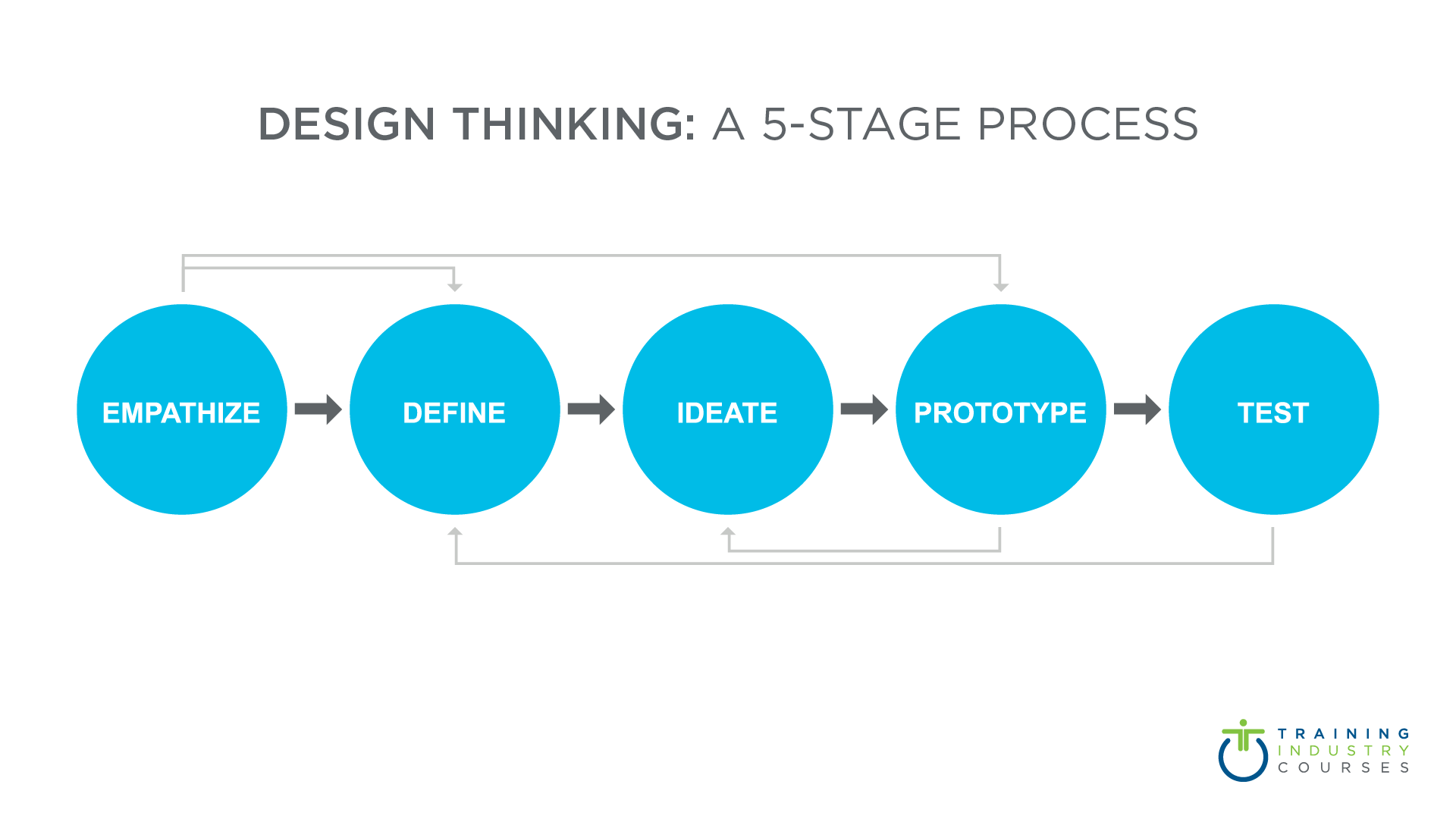Design thinking is a five-stage process for creative problem solving that is centered around the user. But what if we took those stages and applied them to our processes for generating training content with artificial intelligence (AI)?
AI-generated content can be difficult to optimize. Without quality prompting and clear context, AI models will often provide ill-fitting content that is unlikely to resonate with your learners. At this point, most of us have experience with “bad” AI-generated content, but with the principles we gain from design thinking, we can create AI-generated content that hits the mark and meets our learners’ needs.
This article will highlight how each of the five stages of design thinking can lead you to your best AI-generated content.
Stage 1: Empathize
The first stage of design thinking is to deeply empathize with the context of your learners. What is their mindset? What are their motivations? What does their day-to-day look like? You probably already know the value of this information for your traditional content development processes, but they’re just as important when it comes to your AI inputs.
When it comes to AI prompting, more is generally more. The AI tool lacks any context, so the more you can feed it about your learners, the better an assistant it will be. Provide your AI with the ability to “empathize” with your learners by giving it context about their schedules, technology access, modality preferences, learning culture, manager support and anything else you can to personalize the content that you’re asking the AI to generate.
Stage 2: Define
The second stage of design thinking is to clearly define the problem you’re looking to solve. (Remember, design thinking is a problem-solving technique at its core.) When it comes to a training program, you’re likely trying to solve or prevent some type of performance issue. When generating AI content, it can be easy to get lost or to stray from your original goals, particularly as you get into your iterating phase (more on that in a minute).
As you work with your AI model to generate content, not only should you often remind the AI of the problem you’re looking to solve, but you should consistently remind yourself as well. Iterating with an AI model can turn into a bit of a game of telephone between you and yourself. Keeping your problem and your goals in mind will help keep you on track.
Stage 3: Ideate
The third stage of design thinking is where the benefits of AI will really start to shine. The first two stages, empathizing with your learners and defining your problem, serve to create boundary conditions. The ideate phase is where you set the AI free (within said boundary conditions) to start generating ideas. AI can be used to generate limitless inspiration and content for training solutions.
Of course, we can use AI to generate written content to populate things like eLearning modules, but we can also use AI to:
- Generate course outlines.
- Brainstorm application and social learning activities to accompany existing content.
- Generate compelling training invitations and internal marketing copy.
- Create course assessments or knowledge checks.
- Quickly develop job aids and templates for learners to use.
- Write examples and case studies to bring content to life.
- Write video scripts or even create whole training videos.
- Easily create graphics and models to bring visual learning elements to your programs.
With all these possibilities, you can let your creativity run wild at this stage.
Stage 4: Prototype
The fourth stage of design thinking is to quickly and efficiently create “prototypes” that can be tested or reviewed to get you feedback before you roll out an end-product. Any output from the AI should be considered no more than a prototype.
AI content should never be used “raw” or “as is” for several reasons, including but not limited to:
- AI content may just be flat out wrong.
- AI content may be stolen or proprietary.
- AI content may need tweaking to fit your learners’ unique context or to meet specific regulatory and compliance requirements.
AI is incredibly powerful at the prototype stage, because it can quickly give you a “good enough” or “rough” version of what you’re going for. Creating a course outline, job aid resource or building out a potential activity can be done in minutes or hours instead of days or weeks, significantly reducing your development time even if it doesn’t immediately give you a usable end product.
Stage 5: Test
The final stage of design thinking is testing. The testing phase is meant to be a learning process, so it assumes that the initial input is imperfect (a perfect mindset for approaching AI-generated content). Through the testing phase, you should have subject matter experts (SMEs) review and provide feedback on your AI generated content.
Your SMEs should consider:
- Is this content right?
- Is there anything missing from this content?
- Does this content fit the unique needs and context of the learner? You can use the feedback from your SMEs to perfect your final product.
Advancements in AI represent an exciting opportunity for rapid and responsive training content development, but without effective guardrails, it also represents a danger of thoughtless, inaccurate and outright bad training content. A little structure can make all the difference. Using these five stages, you can modernize your content development processes and confidentiality and quickly meet the needs of your learners with quality AI-generated content.




